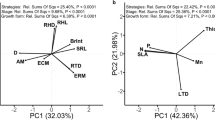Abstract
Tendrils are thread-like organs whose function is to support the stems of many species of climbing plants. Tendrils naturally move (circumnutate) in space. Individual tendrils of cucumber (Cucumis sativus L.) ‘Poinset’ had the vertical component of their mean velocity vector of circumnutation changed when exposed to a range of weak static magnetic fields between 1 and 16 mT. The speed (modulus) of the velocity vector was significantly increased (p=0.016) in the vicinity of a magnet, but its direction did not show a definite trend with respect to the magnet. Although cucumber tendrils bear static positive charges, they did not behave as charged bodies do in a magnetic field, neither did they show a magnetotropic response. In fact, tendrils showed a nastic response to magnetism. Magnetic fields affected some processes underlying the movement of circumnutation, but no clear interpretation of them can be given presently on the basis of the known effects of magnetism on plants. It is clear that cucumber tendrils, because of some inherent susceptibility to magnetism or their particular size and shape, are very sensitive to relatively low static magnetic field strengths.
Similar content being viewed by others
References
Bünning, E., in: Handbuch der Pflanzenphysiologie, vol. XVII/1, p. 1. Ed. W. Ruhland. Springer-Verlag, Berlin-Göttingen-Heidelberg 1959.
Johnsson, A., in: Encyclopedia of Plant Physiology (N. S.), vol. 7, p. 627. Eds A. Pirson and M. H. Zimmermann. Springer-Verlag, Berlin-Heidelberg-New York 1979.
Bünning, E., in: Handbuch der Pflanzenphysiologie, vol. XVII/1, p. 255. Ed. W. Ruhland. Springer-Verlag, Berlin-Göttingen-Heidelberg 1959.
Murr, L. E., Nature206 (1965) 467.
Audus, L. J., and Whish, J. C., in: Biological Effects of Magnetic Fields, p. 170. Ed. M. F. Barnothy. Plenum Press, New York 1964.
Baillaud, L., in: Handbuch der Pflanzenphysiologie, vol. XVII/2, p. 562. Ed. W. Ruhland. Springer-Verlag, Berlin-Göttingen-Heidelberg 1962.
Hollander, M., and Wolfe, D. A., Nonparametric Statistical Methods. J. Wiley & Sons, New York-London-Sydney-Toronto 1973.
Jaffe, M. J., Physiologia Pl.26 (1972) 73.
Simon, N. J., Biological Effects of Static Magnetic Fields. A Review. International Cryogenic Materials Commission, Inc., Boulder, CO 1992.
Badot, P.-M., Bonnet, B., and Millet, B., C. r. Acad. Sci. Paris sèrie III,311 (1990) 445.
Spalding, E. P., and Cosgrove, D. J., Plant Cell Envir.16 (1993) 445.
Brown, A. H., in: Advances in Space Biology and Medicine, vol. 1, p. 129. Ed. S. L. Bonting. JAI Press, Greenwich, CT 1991.
Author information
Authors and Affiliations
Rights and permissions
About this article
Cite this article
Ginzo, H.D., Décima, E.E. Weak static magnetic fields increase the speed of circumnutation in cucumber (Cucumis sativus L.) tendrils. Experientia 51, 1090–1093 (1995). https://doi.org/10.1007/BF01946923
Received:
Accepted:
Published:
Issue Date:
DOI: https://doi.org/10.1007/BF01946923




